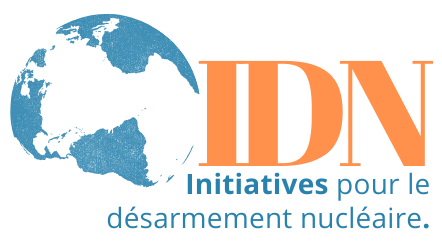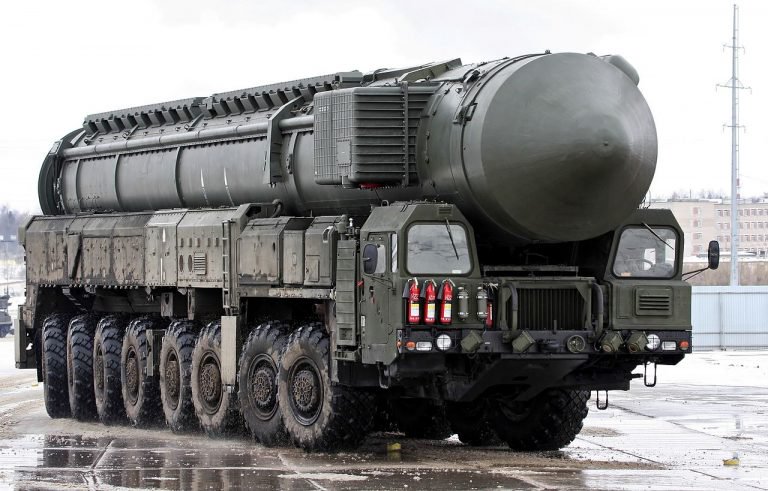L’article ci-dessous réfute les arguments en faveur de la réduction du statut d’alerte des missiles nucléaires terrestres intercontinentaux américains (ICBM). Il conteste que ce soit un moyen de prévenir un tir accidentel ou non autorisé, qui pourrait résulter d’un piratage informatique ; il affirme que cela inciterait une première frappe à l’encontre des États-Unis ; et il estime qu’une mesure unilatérale américaine n’inciterait nullement les autres puissances nucléaires à imiter les États-Unis.
En réalité, cet argument est inquiétant pour les raisons suivantes.
Il existe actuellement quelque 1800 missiles (ICBM ou sous-marins) dans le monde prêts à être tirés en quelques minutes. Le lancement accidentel ou non autorisé d’un nombre même limité de tels missiles provoquerait une catastrophe nucléaire inacceptable par la communauté internationale. C’est pourquoi celle-ci demande depuis plusieurs années aux puissances nucléaires de réduire le statut opérationnel de ces missiles, à titre unilatéral, bilatéralement ou multilatéralement. Les puissances nucléaires l’ont accepté dans le cadre du TNP dès 2000 puis en 2010. Mais aucun progrès n’a été réalisé en pratique. Le risque de piratage informatique est croissant (voir l’étude de NTI à ce sujet, ainsi que l’étude par Chatham House des incidents nucléaires auxquels le monde a échappé de justesse). En tout état de cause, afin de diminuer le risque nucléaire, une réduction du statut opérationnel des missiles nucléaires devrait s’appliquer à toutes les puissances nucléaires, à tous leurs missiles (et non seulement aux ICBM). Elle est à considérer à la fois comme une mesure de confiance et une étape vers la réduction de l’importance stratégique des armes nucléaires et de leur élimination à terme.
Marc Finaud
Ci-dessous l’article de Breaking Defense du 14 décembre 2017
By Rebecca Hersman and Bert Thompson
U.S. early warning systems detect what appears to be the launch of multiple nuclear-tipped missiles in Russia, and the United States’ leadership is forced to make a snap decision based on incomplete information. Do we respond against the potential attack with our own ICBM forces and escalate the situation to a full-scale nuclear war, or do we decide to wait and risk losing our land-based deterrent? We can all agree that this is the ultimate nightmare scenario.
Proponents of de-alerting nuclear weapons—that is, removing ground-based ICBMs from a status at which they can be launched in a matter of minutes—make a number of arguments centered around reducing nuclear risk, especially the risk of accidental or inadvertent launch. They envision a number of scenarios that could result in the United States launching its missiles erroneously: a satellite receives a false warning of an attack or hackers “spoof” an incoming missile, and use-or-lose pressures emanating from putting nuclear weapons on “hair trigger alert” force leaders to escalate to full-scale retaliation. Some, like Global Zero, claim that the cyber threat “is reason enough to remove nuclear missiles from launch-ready alert.”
The solution, they contend, is staring us in the face: take the weapons off high alert and de-mate warheads from our missiles. Further, they argue that this unilateral action would spur Russia or other adversaries to do the same, triggering a global reduction in nuclear risk.
To a degree, they’re right. These risks do exist, and we need to think long and hard about solutions to each of them. However, de-alerting is more of a solution in search of a problem, as the policy prescription does not fit the symptoms. Three main areas of concern emerge out of the debate over de-alerting. First, the threat of cyber attack would not disappear if we were to de-alert our nuclear weapons. Second, the decision makers contemplating whether or not to launch a nuclear strike would not be able to make a “better” decision in the event of a nuclear strike if the ICBMs were de-alerted. Third, de-alerting may embolden adversaries rather than pacify them, as it could provide the opportunity for a decapitation strike against the United States.
We need to recognize calls for de-alerting as what they really are: a means to reduce the utility of the U.S. missile force and implement a de facto No-First Use (NFU) policy. Shifting the argument away from alert status and centering it on the effects of such a policy will further dialogue on the issue and get to the core of proponents’ concerns.
Like many other hot-button defense issues, those in favor of de-alerting nuclear forces point to the threat of cyber attacks on the nuclear arsenal. They rightly worry about this, as we do need to be concerned about cyber attacks on all elements of our nuclear force. Hackers have made advances that could disrupt our core conventional and nuclear command and control systems and pose a critical national security risk that needs to be addressed as rapidly as possible. But the threats of cyberattack do not necessitate de-alerting, as cyberattacks against command and control would remain a threat in any nuclear scenario, alert or de-alert.
Instead of fundamentally changing U.S. nuclear posture because of these threats, we should push for baking in greater resilience and cybersecurity measures. These measures will be even more important as the United States begins its $1.2 trillion nuclear modernization program. Modernization may introduce more complex systems for nuclear command and control and new vectors for attacks and, consequently, must come with investments in more robust cyber defenses.
There are general steps that should be taken to secure any critical U.S. government system, but especially those responsible for nuclear command and control. As outlined in the Defense Science Board Task Force on Cyber Deterrence, there are a number of steps the United States can take to hedge against cyber threats to critical nuclear systems. Establishing a “thin line” of strategic offensive systems—conventional, nuclear, and cyber options—to respond in crisis scenarios would do much more to reduce the risk posed by cyber threats, as it would ensure a capable and ready infrastructure to respond after a crippling attack.
Efforts to improve cyber attribution may also enhance deterrence against actors who believe they can attack our systems without any risk of being held accountable for their actions. Finally, we can tailor our cyber response to specific adversaries and establish more rungs—diplomatic measures, economic sanctions, etc.—in the escalation ladder for responding to cyber attacks, clearly demonstrating to our enemies that they will be punished for meddling with our strategic capabilities. Each of these measures would improve our overall response to cyber threats without adjusting our nuclear posture in a manner that would make us more vulnerable to attack.
In the event of a nuclear attack, the current alert posture would provide a known amount of decision time while still maintaining the option of response. Because ICBM controllers are well-trained on executing launch orders, decision makers know exactly how long they have until the last possible moments to issue such an order. Weapons on alert provide decision makers the most possible time for discussion in the event of a first strike because they are ready to launch at a moment’s notice. Furthermore, if weapons are de-alerted, the time it would take to put the weapons back on alert could cause them to be eliminated by an adversary’s first strike. The process of putting them back on alert would take hours at a minimum, making the proposition that we could respond in this scenario dubious at best. De-alerting does not allow the president to make a “better decision”; it increases the possibility of the ICBM leg of the triad being knocked out before launch.
De-mating nuclear warheads from their ICBMs could place the U.S. nuclear arsenal at significant risk and perhaps even invite a first strike from adversaries. Current procedure requires warheads be placed at central facilities at each ICBM base; a hypothetical de-alert would isolate the warheads in these facilities, which in turn would require much fewer enemy missiles to eliminate. Currently, the U.S. inventory of 400 missiles is deployed across the sprawling fields of the American Midwest, requiring adversaries to commit to a massive strike if they hope to render the U.S. incapable of massive and rapid retaliation. Combined with the nuclear submarine force and strategic bombers, this disincentivizes a first strike from adversaries as the likelihood that the entire U.S. arsenal would be destroyed is minimal.
However, if the warheads were de-alerted, de-mated, and put into secure storage facilities at each of the three ICBM bases in the Midwest, the number of warheads required to eliminate the U.S. ICBM force drops significantly. This frees up the rest of the adversary’s nuclear arsenal to target U.S. bomber bases and strategic submarines. This shift may change the adversary’s calculus and create an overwhelming incentive for the adversary to attempt a first strike on our nuclear arsenal. Ultimately this undermines the deterrent value of our nuclear force across the board, which has widespread geopolitical implications.
If an adversary perceives that the United States does not have the capability to quickly and immediately respond to a nuclear attack, it may decide to behave more aggressively towards both the U.S. and its allies. There would be little incentive for adversaries to reciprocate our posture in this instance and, even if publicly they did so, the inability to verify that they have de-alerted their forces means the risk of first strike would remain.
Removing our arsenal from alert status does not reduce its vulnerability to cyber attacks, nor does it allow for more thoughtful decision making during a crisis. The practical effect of de-alerting is to diminish the role of the ICBM leg of the nuclear triad to the point of irrelevance. By eliminating the ICBMs as a rapid response force, de-alert proponents are essentially arguing for a nuclear posture that is less responsive, more defensive, and more closely resembles a dyad with bombers and nuclear submarines.
It’s important to call a spade a spade. If we are going to have a debate whether we need a triad for deterrence, let’s have it. In a time of rising nuclear modernization costs, the argument to spend less on our ICBMs is appealing and enjoys the support of many in the nuclear community. But let’s have that discussion, not one that attempts to backdoor a way to a nuclear dyad. To argue that de-alerting nuclear weapons allows us to maintain our current posture, only with less risk, is disingenuous and distorts the argument away from the true goal of its proponents. De-alerting is an arms control placebo: it may put your mind at ease, but it does not cure the symptoms.
This report is produced by the Center for Strategic and International Studies (CSIS), a private, tax-exempt institution focusing on international public policy issues. Its research is nonpartisan and nonproprietary. CSIS does not take specific policy positions. Accordingly, all views, positions, and conclusions expressed in this publication should be understood to be solely those of the author(s).
© 2017 by the Center for Strategic and International Studies. All rights reserved.

